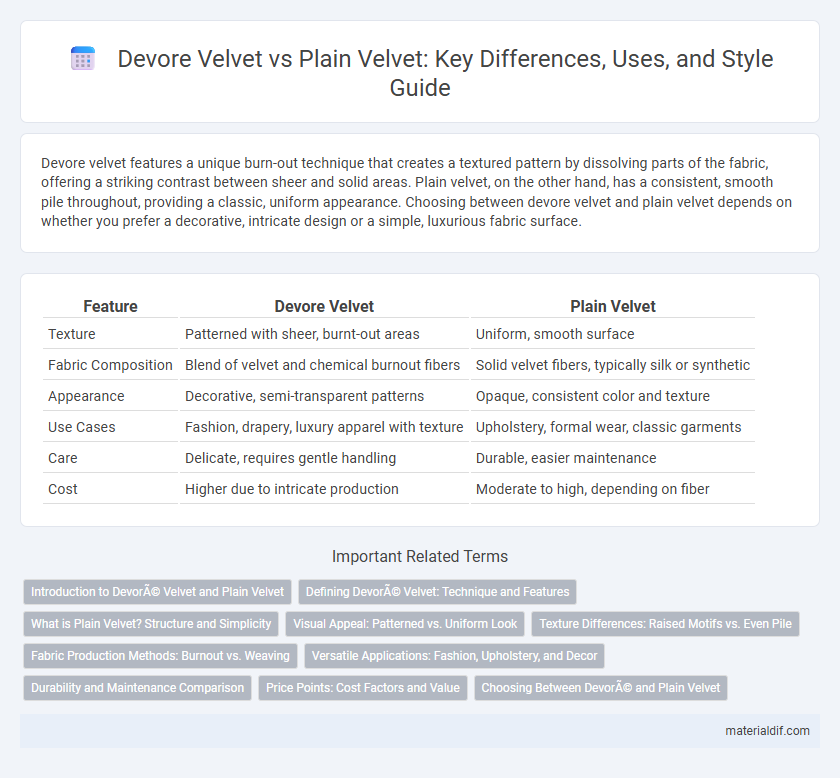Devore velvet features a unique burn-out technique that creates a textured pattern by dissolving parts of the fabric, offering a striking contrast between sheer and solid areas. Plain velvet, on the other hand, has a consistent, smooth pile throughout, providing a classic, uniform appearance. Choosing between devore velvet and plain velvet depends on whether you prefer a decorative, intricate design or a simple, luxurious fabric surface.
Table of Comparison
| Feature | Devore Velvet | Plain Velvet |
|---|---|---|
| Texture | Patterned with sheer, burnt-out areas | Uniform, smooth surface |
| Fabric Composition | Blend of velvet and chemical burnout fibers | Solid velvet fibers, typically silk or synthetic |
| Appearance | Decorative, semi-transparent patterns | Opaque, consistent color and texture |
| Use Cases | Fashion, drapery, luxury apparel with texture | Upholstery, formal wear, classic garments |
| Care | Delicate, requires gentle handling | Durable, easier maintenance |
| Cost | Higher due to intricate production | Moderate to high, depending on fiber |
Introduction to Devoré Velvet and Plain Velvet
Devore velvet features a unique burnout technique where parts of the velvet pile are chemically dissolved to create a semi-transparent pattern, offering a luxurious textured contrast against the sheer base fabric. Plain velvet, on the other hand, is characterized by its dense, uniform pile that provides a rich, smooth surface with a soft sheen, ideal for a classic, opulent aesthetic. Both fabrics are prized in fashion and interior design, with Devore velvet delivering intricate, artistic patterns and plain velvet emphasizing depth and color intensity.
Defining Devoré Velvet: Technique and Features
Devore velvet, also known as burnout velvet, is created through a chemical process that dissolves fibers in specific areas to form a distinctive semi-transparent pattern. This technique contrasts with plain velvet, which has a uniform pile and texture without any sheer or patterned effects. Devore velvet combines plush softness with artistic design, making it popular in fashion and upholstery for adding visual depth and tactile variation.
What is Plain Velvet? Structure and Simplicity
Plain velvet is a fabric characterized by a uniform pile surface created through a woven structure where the warp and weft threads produce a smooth, soft texture without patterns. Its simplicity lies in the consistent, dense pile resulting from cut threads standing upright, offering a luxurious feel without additional design elements. The structure of plain velvet emphasizes durability and richness, making it ideal for classic upholstery and apparel where subtle elegance is preferred over intricate detailing.
Visual Appeal: Patterned vs. Uniform Look
Devore velvet features a distinctive patterned texture created by chemically burning out parts of the fabric, offering a dynamic and visually intricate design that captures light and shadow for a luxurious effect. In contrast, plain velvet presents a uniform surface with a smooth, rich pile that reflects light evenly, resulting in a consistent and elegant appearance. The choice between devore and plain velvet impacts interior aesthetics, with devore providing bold, artistic patterns, while plain velvet delivers timeless sophistication.
Texture Differences: Raised Motifs vs. Even Pile
Devore velvet features a distinctive texture characterized by raised motifs created through a burnout technique that dissolves parts of the fabric, leaving patterned velvet areas contrasted with sheer sections. Plain velvet, in contrast, has an even pile with a uniform, plush surface that provides a smooth and soft hand feel. The textural variation of devore velvet adds dimensionality and visual interest, while plain velvet emphasizes consistent density and tactile softness.
Fabric Production Methods: Burnout vs. Weaving
Devore velvet is produced using a burnout technique where a chemical gel dissolves cellulose fibers in a mixed-fiber fabric, creating a semi-transparent pattern through selective fiber removal. Plain velvet, on the other hand, is woven using a double cloth method that forms a dense, plush pile by weaving two layers of fabric simultaneously, resulting in a uniform texture. The burnout process gives devore velvet its signature sheer and velvety contrast, while weaving in plain velvet ensures consistent thickness and softness throughout the fabric.
Versatile Applications: Fashion, Upholstery, and Decor
Devore velvet features a distinctive burnout pattern achieved by chemical treatment, creating a sheer, textured contrast that is ideal for high-end fashion, elegant drapery, and artistic upholstery. Plain velvet, with its uniform, plush surface, offers durability and a luxurious feel suited for classic clothing pieces, heavy-duty upholstery, and timeless home decor accents. Both types provide versatile applications, but Devore velvet excels in stylish, breathable garments and decorative elements requiring visual depth, while plain velvet supports everyday use and rich tactile experiences.
Durability and Maintenance Comparison
Devore velvet features a unique burnout technique that creates semi-transparent patterns by chemically dissolving fibers, making it more delicate and requiring gentle care compared to plain velvet. Plain velvet is generally more durable due to its uniform pile structure, offering better resistance to wear and easier maintenance through regular cleaning. While plain velvet withstands frequent use and washing, devore velvet demands careful handling to preserve its intricate design and fabric integrity.
Price Points: Cost Factors and Value
Devore velvet typically commands a higher price point than plain velvet due to its intricate burnout technique that requires specialized production processes and skilled artisans. The cost factors for devore velvet include the price of chemicals and additional labor, which contribute to its luxury appeal and exclusivity. Plain velvet offers greater affordability and durability, making it a cost-effective choice for everyday use while devore velvet is valued for its unique texture and aesthetic, justifying the premium investment.
Choosing Between Devoré and Plain Velvet
Choosing between Devore and Plain Velvet depends on the desired texture and visual impact; Devore Velvet features a unique burn-out pattern that combines sheer and solid areas, adding depth and decorative elegance. Plain Velvet offers a uniform, plush surface prized for its richness and versatility in upholstery and fashion. Understanding the end use and aesthetic preference guides the selection for luxury design applications.
Devoré Velvet vs Plain Velvet Infographic

 materialdif.com
materialdif.com